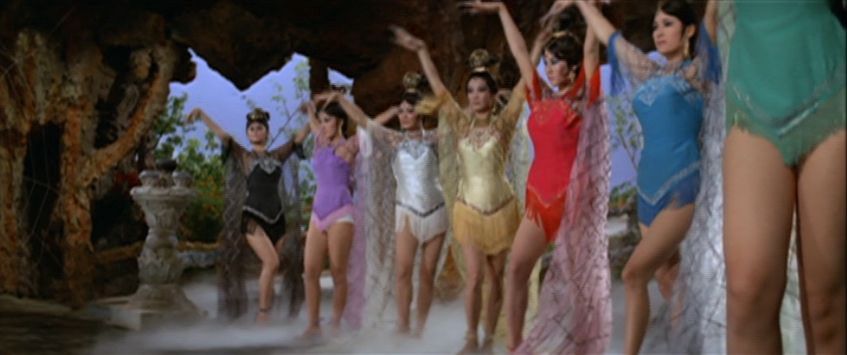Ho Meng-hua Capsule Reviews

Cave of the Silken Web (1967) — June 3, 2015
An impressive collection of legs.
Transitional film for the Shaws, half a huangmei musical, half an action film. Not a state-of-the-art swordplay film in the style King Hu and Chang Cheh were making in 1967, but an older, more theatrical kind of action, aided by a none too subtly sped-up camera and special effects pioneered by Méliès. This was part of a series of films director Ho Meng-hua made adapting stories from Journey to the West. The first two featured Cheng Pei-pei and this one could have used someone of her star-caliber. Angela Yu Chien as the villainous and kind of slutty Third Sister (the one in red) is the best we get. Without a real standout performer, the focus is instead on the narrative, an impressive tangle of schemes and deceptions that effectively convey the spirit of the novel, at least as much as I’ve read of it, within a wildly colorful Shaw soundstage.
Vengeance is a Golden Blade (1969) — October 28, 2010
A solid film from director Ho Meng-hua about a man who’s betrayed by his wife to the Vicious Long Brothers. Crippled, he flees to the mountains with his daughter to live with an herbalist and his son. After spending the next 15 years or so crafting a sword which will defeat his stolen Golden Blade, he inexplicably does everything he can to keep his daughter, who’s apparently been training for this her whole life, from taking revenge. Much of the plot of Josef von Sternberg’s The Shanghai Gesture ensues, which makes for some interesting melodramatics for a kung fu film. Chin Ping is pretty good as the daughter, but there’s never really enough fighting here to keep things interesting, and the final sword fight is pretty anticlimactic, given the hype created by that killer title.
Black Magic (1975) — October 15, 2018
Can’t get over how bad the fights are in this, a movie featuring two of the best martial arts stars of the 1970s, Lo Lieh and Ti Lung. They look so amateurish, like the fights in a Hollywood film from the same period. There’s no credited action choreographer, so that’s probably why.
Black Magic II (1976) — October 19, 2018
I’m not sure why the Metrograph is starting their Shaw Horror series with the second of Ho Meng-hua’s two Black Magic films, but I assume it has something to do with print availability and limited programming space. And besides, the second one is better anyway. The two films, in typical Hong Kong fashion, are not directly related in any way, only in cast, crew, setting, and basic plot. That plot will be the basis of at least half the films in the series: a young, modern Hong Konger travels to Southeast Asia where they run afoul of an evil wizard, who uses a variety of mystical charms to torture them. Spells include but are not limited to: demonic possession, voodoo dolls, all manner of vile animals (bats, insects, worms, rats, scorpions) which attack from both outside and within the victims’ bodies, zombies, and spirit energy manifested as brightly-colored lights. The only defense the Hong Konger has is to turn to a priest, Buddhist or Taoist, who then engages in spiritual combat with the villain. Unlike in Western, Christian-sourced horror films, Chinese religions in these movies are not arbiters of moral clarity but rather mere window-dressing for the eerie special effects, their primacy over the primitive animism of Southeast Asia concomitant with the superiority of modern, urban Hong Kong Chinese culture.
Black Magic II features Ti Lung and Lo Lieh, major wuxia stars dating back to the late 60s. Ti plays a doctor who travels to “A Tropical City” (it’s in Thailand, in all these movies the evil comes from Thailand) with his wife to visit and help out a couple of fellow doctors. It seems Lo is an evil wizard with a mansion full of zombies, and his recipe for immortality requires young female victims. The doctors are on the case, evincing an impressive inability to accept the obvious mystical explanations for the phenomena they witness. The plot structure owes more than a little to Dracula, with Lo’s vampiric villain subsisting not on blood, but breast milk. Lo is always a reliable bad guy, and the sequel is better than its predecessor if for no other reason than that it centers him in the story rather than having him be a merely preliminary victim. This was not the first time Shaws sent a crew to Thailand to shoot a couple of movies at the same time: Chang Cheh did so five years earlier with Ti Lung and David Chiang, resulting in Duel of Fists and Angry Guest. It’s interesting to see how much of the studio’s distinctive style survived the trip and what, if anything they brought back. One item of note that did return is a dress that heroine Tanny Tien briefly wears, which Kara Hui will make iconic five years later in My Young Auntie (if you’ve seen that movie, you know exactly which dress).
